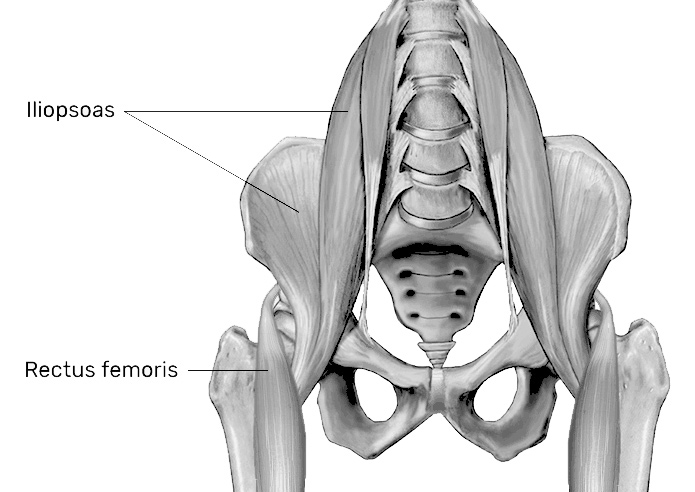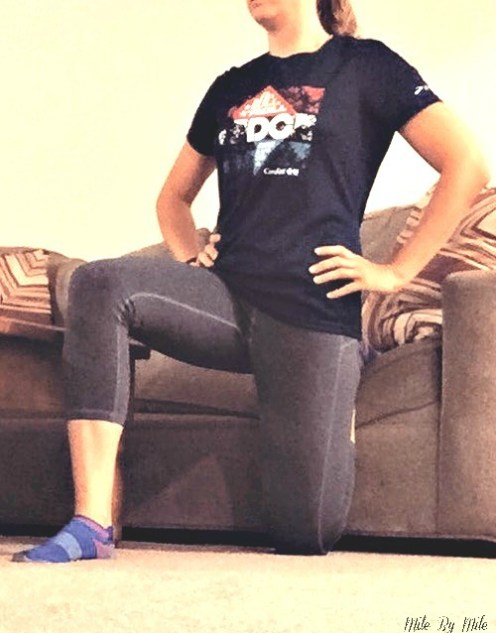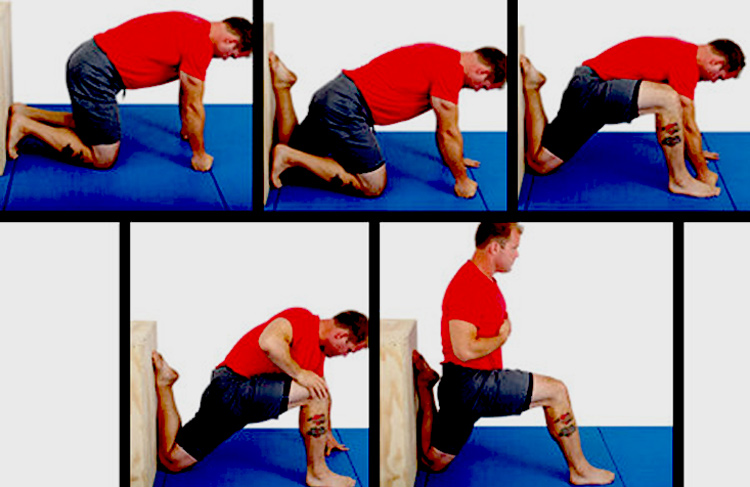Tight hips can have a huge impact on many aspects of your life. In the gym, they can stop you from squatting or lunging properly. Out on the sports field, they can stop you from reaching top speed when you run. Tight hips can also be a source of low back and knee pain.
In short, tight hips SUCK!
Tight hips are a common problem, and a lot of people have them. Why are tight hips so prevalent? It’s because of something you are probably doing right now…sitting on a chair.
Sitting on a chair puts your hips into flexion. With your hips flexed, the muscles on the front of this joint are placed in a shortened position. Your body adapts to habitual sitting by making your anterior (front) hip muscles tighter.
These muscles are:
- Iliacus and psoas major – collectively called iliopsoas
- Rectus femoris – the longest quadriceps muscle

These muscles are often referred to as the hip flexors. That’s a good name because that’s exactly what they do – they flex your hips!
If your hip flexors become tight, when you stand or try to extend your hips, you have to work against the tension of these tight muscles and will lose range of motion. In other words, you won’t be able to extend your hip as far as normal. Imagine running but not being able to drive your leg to the rear; that’s how much tight hip flexors can limit your range of motion.
These tight muscles are often described as hypertonic, which means they are partly contracted. This hypertonicity causes another problem…
Muscles are arranged in pairs on opposite sides of your joints. When one muscle contracts, the opposing muscle must relax to allow easy movement to occur. This is called reciprocal inhibition. For example, if your biceps contract to bend your arm, your triceps must relax. This is a reflexive action.
Overly tight muscles cause the opposing muscles to relax and weaken. In the case of tight hips, hypertonic iliopsoas and rectus femoris inhibit the glutes and hamstrings. If these muscles aren’t firing correctly, you won’t be able to extend your hips as powerfully as you otherwise could. In short, tight hips make your glutes and hamstrings sleepy.

The good news is that you can fix all of these problems in the comfort of your own home with the couch stretch. This exercise is so-called because, in some variations, you do it with your rear foot on a couch.
Read also Lunges vs. Squats – Which Exercise is Best?
How to do the couch stretch
The couch stretch is not an easy exercise to master, especially if you have tight hips and find stretching them challenging. If you can’t do the couch stretch as described below, scroll down to the variations, all of which are a little easier and ideal for beginners.
Make this exercise more comfortable and a little easier by warming up beforehand. A few minutes of light cardio will get your blood pumping and increase tissue temperature and elasticity. Your muscles will relax and stretch more easily if you are warm.
How to do couch stretch:
1 – Kneel down on all fours with your feet flat against a wall. Your hips should be directly over your knees and your shoulders directly over your hands. Brace your abs and arch your lower back slightly; a neutral spine. Tuck your chin in and lengthen your neck.
2 – Bend one leg and place your knee at the bottom of the wall, so your shin is vertical. If this is uncomfortable, place a mat or thin cushion under your knee. Point your toe to get your shin as flat to the wall as possible. In this position, your front shin should be upright too. If it isn’t, move your foot to make it so.
Relax and breathe normally; do not tense up any part of your body, including your neck and face. Stay in this position for a few seconds to get used to it and begin gently stretching your hips.
3 – Push down through your front leg and gradually raise your torso into an upright position. Place your hands on your front thigh for support. The more upright you are, the deeper the stretch will be. Don’t force it. Only come up as far as you feel comfortable.
Make sure this movement comes from HIP extension, and not BACK extension. If you are arching your back, you aren’t stretching your hip. Your spine should remain neutrally aligned and not excessively arched.
Adjust the angle of your torso to reflect your flexibility. For some, this may mean that you keep your hands on the floor until your flexibility improves.
4 – Hold this position for 30-60 seconds. During that time, you should feel the hip flexors starting to relax. Gently stretch a little deeper. Ease off if you start shaking or feel pain. It’s normal to feel tension in the area you are stretching, but pain means you have gone too far.
5 – After stretching for 2-3 minutes, ease out of the stretch and swap sides. It’s normal to have one hip tighter than the other, so spend more time on the side that feels the tightest.

Common mistakes to look out for when doing this stretch include:
- Not pushing your knee all the way back into the wall
- Not placing your rear shin flat against the wall
- Having your feet too close together, so your front shin is not vertical
- Using too narrow a stance – your feet should be about hip to shoulder-width apart
- Rounding or hyperextending your lower back
- Twisting your hips or shoulders
- Holding your breath
- Tensing up
- Trying to stretch too far too soon
For best results, do the couch stretch every day. Why so often? Because every day, you spend time in a chair, which shortens these important muscles. Stretching them daily will help offset the effect of prolonged sitting.
Couch Stretch Variations
If you have very tight hip flexors, the couch stretch may be too much for you right now. If you try and force yourself to do this stretch, you could end up injured or, at the very least, frustrated with your inability to do it correctly.
The good news is that there are a few alternatives and variations that you can use instead. These stretches target the same muscles but are a bit more forgiving. Use these exercises to develop the flexibility necessary to do the couch stretch properly.
1 – Standing couch stretch
This exercise is not only easier than the regular couch stretch, but you can also do it to break up long periods of sitting at your desk. You don’t even have to leave your workstation to do it!
How to do it:
- Stand with your back to your chair. Bend one leg and place your knee on the seat, and your foot on the backrest. Move your front foot forward slightly.
- Without extending your lumbar spine, ease your hips forward to stretch your hip flexors.
- Hold for the desired duration and then switch sides.
- Do not use a chair with wheels for this exercise or, if you must, place the chair against a wall or desk so it won’t move.
2 – Runner’s lunge
The runner’s lunge is a gentle way to stretch your hip flexors, although it’s not so good for stretching rectus femoris. Because it’s such an easy exercise, you shouldn’t need much of a warm-up before doing it. This stretch is an excellent preparatory move before moving onto the couch stretch.
How to do it:
- Kneel down on the floor and take a large step forward into a lunge position. Your front shin should be vertical, knees behind your toes.
- With your torso upright, and using your arms for support if required, ease your hips forward until you feel a stretch in your hip flexors. Do not extend your lumbar spine.
- Make this stretch more effective by moving your rear leg back slightly.
- Swap legs and repeat.
You can make this stretch harder, and stretch your quads at the same time, by bending your rear leg and holding your foot, pulling it in toward your butt. This exercise feels a lot like the couch stretch.
3 – High lunge
The good thing about the high lunge is that you don’t have to kneel down on the floor to do it. That makes it a) easy on your knees, and b) means you can do it almost anywhere without dirtying your pants. Do this exercise anytime you need a quick hip stretch.
How to do it:
- Take a large step forward as though you were going to do a lunge. Keeping your rear leg straight, bend your front knee and push your hips forward until you feel a stretch in your hip flexors. Make sure your rear knee is pointing forward. Do not turn it inward or outward.
- Place your hands on your thighs or against a wall if required.
- Hold for 30-60 seconds and then switch sides.
Read also: Weak, soft, flat glutes? Try these 12 best glute exercises for mass
Wrapping up
Tight hips are a common problem, but not an insurmountable one. Because tight hips can have such a significant impact on your life in and outside the gym, it’s worth spending a little time each day undoing the effects of prolonged sitting by stretching these critical muscles. Stretching them daily is a very good idea.
You should also look for opportunities to sit less and stand or walk more. Standing and walking more will help prevent your hips from tightening up in the first place, and an ounce of prevention is always better than a pound of cure!
Whether you want less back pain, better posture, or want to run faster or squat deeper, you need to stretch your hip flexors, and a few minutes a day is all you need.

